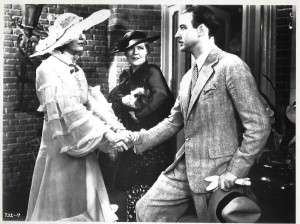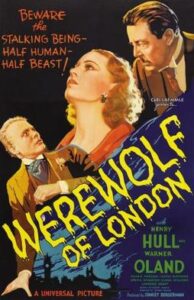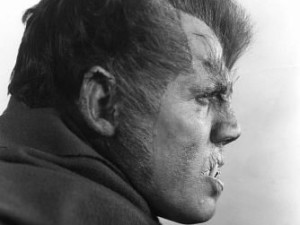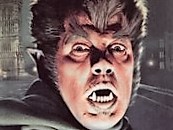Werewolf of London *** (1935, Henry Hull, Warner Oland, Valerie Hobson, Lester Matthews, Spring Byington) – Classic Movie Review 3763
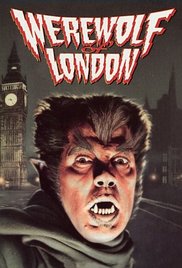
Director Stuart Walker’s 1935 Universal horror movie Werewolf of London is the first Hollywood mainstream film to feature a werewolf. It stars Henry Hull as Dr Wilfred Glendon, who transforms from English botanist into a werewolf (with the help of John P Fulton’s admirable Thirties special effects) in this creakily entertaining old chiller. Jack Pierce’s minimalist werewolf design has become iconic, and so has the film.
On a botanical expedition, he is after a rare plant in Tibet when a strange creature attacks him in the dark, and he turns into a werewolf back in London, terrorising the citizens. His one hope to cure his sickness is the juice of a rare Tibetan flower.
Valerie Hobson plays his wife Lisa and Warner Oland plays the oriental werewolf Dr Yogami, with Spring Byington as Miss Ettie Coombes and Lester Matthews as Paul Ames.
The movie boasts a good, attractive look, interesting characters and some strong performances, particularly Warner Oland’s (Oland’s Dr Yogami opines: ‘The werewolf is neither man nor wolf, but a Satanic creature with the worst qualities of both.’)
Also in the cast are Zeffie Tilbury, Lawrence Grant, Clark Williams, J M Kerrigan, Charlotte Granville, Ethel Griffies, Jeanne Bartlett, Harry Stubbs, and Egon Brecher.
The writers are John Colton for the screenplay and Robert Harris for the story, with uncredited work by Harvey Gates, Robert Harris and Edmund Pearson.
There are two locations, Tibet and London, but it was shot at Vasquez Rocks Natural Area Park, 10700 W Escondido Canyon Rd, Agua Dulce, California, and in the studio at Universal Studios, 100 Universal City Plaza, Universal City, California. The film does not state its time period, though the appearance of a 1933 car suggests it has a contemporary setting, but the costumes have an Edwardian-era look.
Bela Lugosi was to play Dr Yogami, but he was busy filming Mark of the Vampire (1935).
Jack Pierce’s werewolf make-up for Henry Hull originally looked like his work in 1941 on Lon Chaney Jr in The Wolf Man, but the design ended up much less elaborate after Henry Hull, an accomplished makeup artist, argued that the script said the other characters could recognise the werewolf as Dr Glendon. After the two men argued, Hull went to the Universal studio president, Carl Laemmle, who approved, angering Pierce. However, Pierce’s minimalist werewolf design has become iconic, and was referenced in 1994’s Wolf with Jack Nicholson and the 1981 film An American Werewolf in London.
The Universal Pictures’ budget was $195,000,. They shot it between 28 January 1935 and 23 February 1935, and they released it on May 13, 1935 (US). It runs 75 minutes.
The werewolf’s howl is a unique audio blend of Hull and a recording of a timber wolf.
The ‘Tibetan’ spoken by villagers is actually Cantonese and Henry Hull is muttering gibberish in his replies.
The score is by Karl Hajos, whose original compositions are interspersed with musical fragments by other composers, including compositions by Heinz Roemheld from Universal’s The Invisible Man and The Black Cat.
Werewolf of London is directed by Stuart Walker, runs 75 minutes, is made and released by Universal Pictures, is written by John Colton (screenplay) and Robert Harris (story), is shot in black and white by Charles J Stumar, is produced by Stanley Bergerman, is scored by Karl Hajos, and designed by Albert S D’Agostino.
The cast are Henry Hull as Dr Wilfred Glendon, Warner Oland as Dr Yogami, Valerie Hobson as Lisa Glendon, Lester Matthews as Paul Ames, Lawrence Grant as Sir Thomas Forsythe, Spring Byington as Miss Ettie Coombes, Clark Williams as Hugh Renwick, J M Kerrigan as Hawkins, Charlotte Granville as Lady Forsythe, Ethel Griffies as Mrs Whack, Zeffie Tilbury as Mrs Moncaster, and Jeanne Bartlett as Daisy, Harry Stubbs, and Egon Brecher.
© Derek Winnert 2016 Classic Movie Review 3763
Check out more reviews on http://derekwinnert.com

